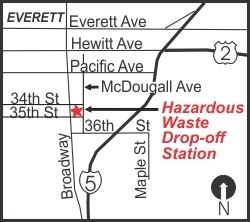- corrosive
- toxic
- ignitable
- reactive ingredients, such as oil-based paints, cleaners, oils, batteries, and pesticides.
Improper disposal can pollute the environment and pose a threat to human health. North Americans generate over 1.76 million tons (over 3.5 billion pounds) of Household Hazardous Waste (HHW) each year. Although it makes up a very small percentage of the waste stream, it causes a large part of the environmental damage that occurs in waste handling and disposal
Hazardous waste material should never be poured down the drain, on the ground, into storm sewers, or put in the garbage. The best strategy for us is to avoid hazardous materials if possible. If you can’t avoid using some hazardous products, safe disposal is very important. Bring hazardous waste from your home to the Snohomish Household Hazardous Waste Facility.
To dispose of your Household Hazardous Waste (HHW) products, keep them in their orginal container if possible, or drain into a container with a secure lid for safe transporting to a drop-off site.
DO:
• Keep HHW products separate (do not mix).
• Bring products in their original containers when possible.
• Seal products to prevent leaks and spills.
• Keep products away from the driver and passengers, i.e., in a trunk, truck bed, or trailer.
• Keep children and pets away from collection sites and events.
DO NOT bring:
- Asbestos
- Business-generated waste
- Electonics
- Empty or leaking containers
- Explosives or ammunition (call local police department)
- Medical waste
- Medicice or pharmaceuticals
- Microwave ovens
- Non-hazardous materials
- Radioactive or infectious waste
- Refrigerator or Freezers
- Unlabelled
A complete list of restricted items can be seen here: https://snohomishcountywa.gov/2550/Waste-Restrictions
Here is some information from the United States Environmental Protection Agency on Hazardous Waste: http://www.epa.gov/epaoswer/non-hw/househld/hhw.html
